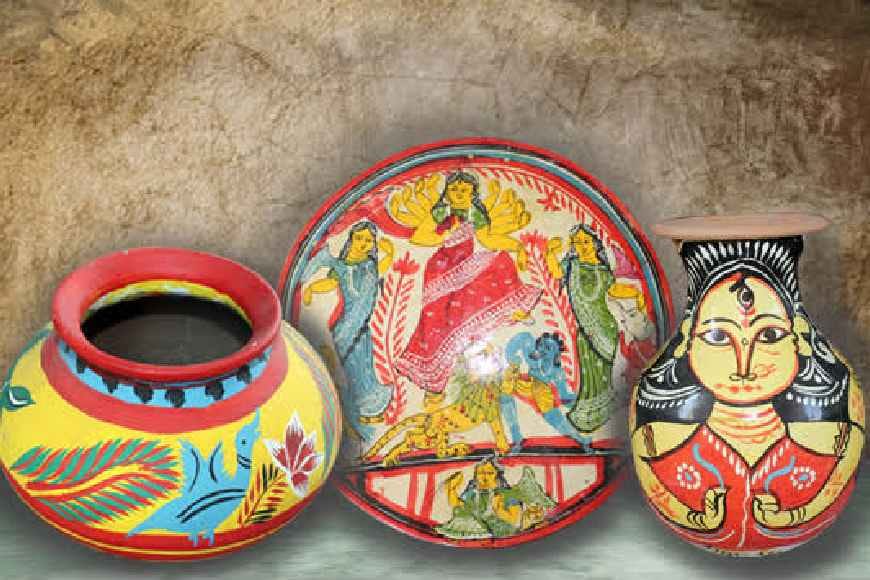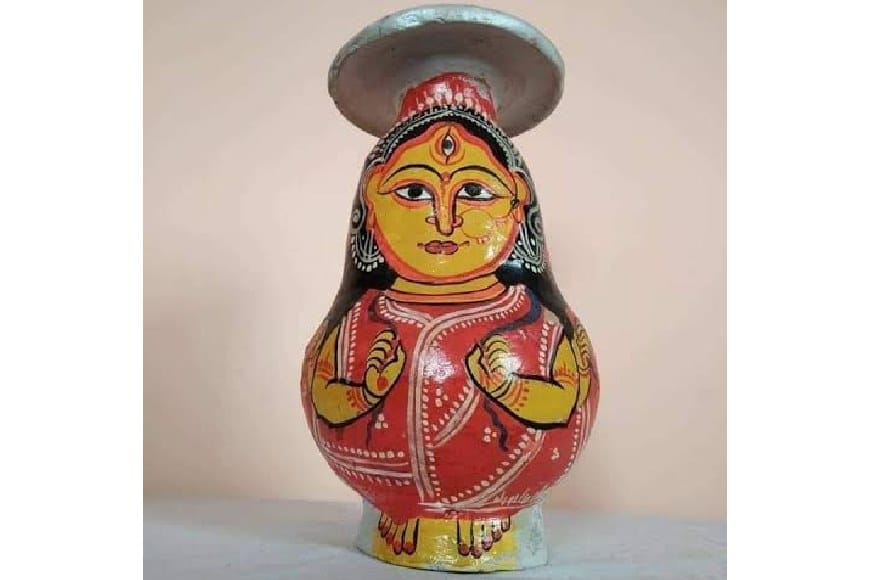The Ghots of Bengal are a piece of Art – GetBengal story

Aparticular art of Bengal is decorating Ghots or round earthen pots offered during various religious ceremonies. At times the Ghot itself is worshipped as a deity symbolizing the idol of a particular goddess. One such deity is the Manasa Ghot. In Barishal, the erstwhile district of East Bengal (now Bangladesh), there is an established practice to offer prayers before these painted Ghots, treated as the Snake Goddess or Ma Manasa. Following Partition, many of these artisans shifted to West Bengal and brought along with them the age-old tradition of this genre of painting. While painting the images of Goddess Manasa on the earthen pitchers or ghots, the folk painters of Bengal maintain a fine balance of form and style. Goddess Manasa’s hands are seen clenching into fists with each of them gripping a snake.

Single strokes are drawn to bring out the folds of the lips and chin. The traditional nose ring, the eyebrows, the three eyes of the Goddess, and the fingers of her hand, the design of snakes with expanded hoods are used to serve as the ornaments of the deity. The body of the Goddess is painted in yellow and the corners of the lips are shaded in vermillion. But the colour of her dress is shown as green on some ghots and as red in others. The eyes are shown to be fixed in a wide look and in many cases tattoo marks shaped as scorpions are shown on the arms. The wide circular base of the ghot is often decorated with lotus designs and it serves as a seat of the deity. Sometimes swans are drawn on the two sides of the Goddess. This art of painting is one of the most relevant examples of the folk art of Bengal.
Also read : Banak – Colour of Bengal’s Clay Art
In earlier days sweets specially prepared as wedding gifts used to be delivered in urn-shaped earthen pots painted in a variety of designs. These pots were covered by convex earthen lids placed with their curved sides facing downwards. The body of the pots was painted to display lotus and other flowers and creepers, fish, butterfly, betel leaves, and a variety of other designs. Attractive colours of red, blue, yellow, and green were applied on the surface of the pots which could be counted as genuine instances of folk art. There is an age-old custom at Rajnagar in Siuri and other areas of Birbhum district to place 6-8 such painted pots under a specially erected canopy where the wedding ceremony takes place. Painted pots of Bengal are also used for sending sweets prepared as wedding gifts in the Kandi area of Murshidabad district. Earthen pots painted in red and white colours , displaying various motives and forms are extensively used by the Muslim community of Howrah and Medinipur for delivering sweets during wedding ceremonies.

In addition to painting with colours on earthen pots, the potters of Panchmura and Sonamukhi often produce various decorations on the body of pots and pitchers by drawing thin and shallow lines on the surface. Figures of fish drawn with many geometric patterns are a common feature of this art. Thereafter through the application of appropriate colours and the usual burning process, the pot finally becomes red or black in colour. Sometimes these earthen vessels are painted in white. The Bengal folk narrative drawn on these earthen pots represents a distinct folk art culture of our state which has been continuing for decades.










